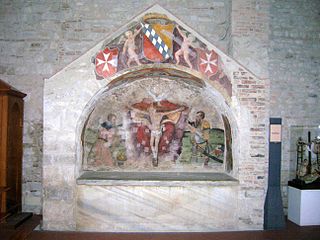
Robert "Guiscard" de Hauteville, sometimes Robert "the Guiscard", was a Norman adventurer remembered for his conquest of southern Italy and Sicily in the 11th century.

William I of Hauteville, known as William Iron Arm, was a Norman adventurer who was the founder of the fortunes of the Hauteville family. One of twelve sons of Tancred of Hauteville, he journeyed to the Mezzogiorno with his younger brother Drogo in the first half of the eleventh century (c.1035), in response to requests for help made by fellow Normans under Rainulf Drengot, count of Aversa.

Drogo of Hauteville was the second Count of Apulia and Calabria (1046–51) in southern Italy. Initially he was only the leader of those Normans in the service of Prince Guaimar IV of Salerno, but after 1047 he was a territorial prince owing fealty directly to the Emperor.

Humphrey of Hauteville, surnamed Abagelard, was the count of Apulia and Calabria from 1051 to his death.

Guaimar IV was Prince of Salerno (1027–1052), Duke of Amalfi (1039–1052), Duke of Gaeta (1040–1041), and Prince of Capua (1038–1047) in Southern Italy over the period from 1027 to 1052. He was an important figure in the final phase of Byzantine authority in the Mezzogiorno and the commencement of Norman power. He was, according to Amatus of Montecassino, "more courageous than his father, more generous and more courteous; indeed he possessed all the qualities a layman should have—except that he took an excessive delight in women."
Guaimar III was the Lombard prince of Salerno from around 994 to his death. Under his reign, Salerno entered an era of great splendour. Opulenta Salernum was the inscription on his coins. He made Amalfi, Gaeta and Sorrento his vassals and annexed much of Byzantine Apulia and Calabria.
Richard Drengot was the count of Aversa (1049–1078), prince of Capua and duke of Gaeta (1064–1078).

Jordan I, count of Aversa and prince of Capua from 1078 to his death, was the eldest son and successor of Prince Richard I of Capua and Fressenda, a daughter of Tancred of Hauteville and his second wife, also named Fressenda, and the nephew of Robert Guiscard, duke of Apulia, Calabria, and Sicily. He, according to William of Apulia, "equalled in his virtues both the duke and his father."

Gisulf II was the last Lombard prince of Salerno (1052–1077).
Guaimar II was the Lombard prince of Salerno from 901, when his father retired to a monastery, to his death. His father was Guaimar I and his mother was Itta. He was associated with his father in the principality from 893. He was responsible for the rise of the principality: he restored the princely palace, built the palace church of San Pietro a campanile, and restored gold coinage.
Gisulf I was the eldest son of Guaimar II, Lombard Prince of Salerno, and his second wife Gaitelgrima. He was associated with his father as ruler in 943 and succeeded him on his death in 952. He took to using the title Langobardorum gentis princeps, "prince of the people of the Lombards". He was originally under the regency of his mother and Prisco (Priscus), treasurer and count of the palace.
John II was the duke of Amalfi from 1029 to 1069 with multiple interruptions. He was the son of Sergius II and Maria, sister of Pandulf IV of Capua. He was the last significant duke of Amalfi before the Norman conquest of 1073.
Maria was ruling Duchess of Amalfi in co-regency with her sons twice: in 1028–29 and in 1034–39. During the reigns of her sons, she appears to have held the actual power.

The Principality of Salerno was a medieval Southern Italian state, formed in 851 out of the Principality of Benevento after a decade-long civil war. It was centred on the port city of Salerno. Although it owed allegiance at its foundation to the Carolingian emperor, it was de facto independent throughout its history and alternated its allegiance between the Carolingians and their successors in the West and the Byzantine emperors in the east.

The Principality of Capua was a Lombard state centred on Capua in Southern Italy. Towards the end of the 10th century the Principality reached its apogee, occupying most of the Terra di Lavoro area. It was originally a gastaldate, then a county, within the principality of Salerno.

The Norman conquest of southern Italy lasted from 999 to 1194, involving many battles and independent conquerors.
The Landulfids or Atenulfings were a noble family of Lombardic origin in the ninth through eleventh centuries. They were descended from Landulf I of Capua, whose own ancestry is unknown and who died in 843. The dynasty produced a line of princes which ruled most of southern Italy at one time or another and even one pope, Victor III.
Pandulf III was briefly the Prince of Salerno from around 3 to 10 June 1052. He was the eldest of four brothers of Gemma, wife of Prince Guaimar IV. He seized the throne in a coup d'état, when he and his brother assassinated Guaimar. He reigned for only a week before he was forced to step down and was promptly murdered.








